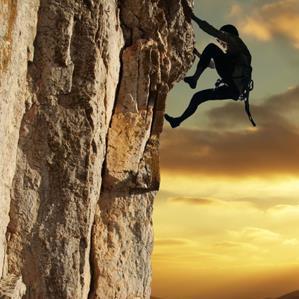What is the largest and hairiest spider in the world?
所有的蜘蛛都能拉丝结网。蜘蛛身体的尾部有一个丝囊,蜘丝就是从这里拉出的。蜘蛛网的作用与我们捕鱼所用的网一样,蜘蛛的窝就在网旁,它用十分敏感灵活的腿编织网,把脚爪放在网上等待着机会,一般来说,它并不需要等很长时间。当昆虫撞到网上的时候,蜘蛛很快就将昆虫包起来,并把它从网上拖到窝里美餐一顿。
蜘蛛是食肉动物。所有的蜘蛛都长有毒牙。蜘蛛的视力很好。无论是六只还是八只眼睛都长成角塔状。这样就很容易从不同的角度观察各个方向的情况。蜘蛛和昆虫有什么不同之处呢?蜘蛛的身体分两部分,而昆虫的身体分三部分。蜘蛛有8条腿,身体两侧各4条,而昆虫有6条腿。在蜘蛛身体的前端,长有毒牙,其中有确实杀伤力很大。但是大部分牙,特别是最常用的那些牙却没有什么毒性。
蟹蜘蛛则不搭网而采取偷猎的战术。它之所以被称作蟹蜘蛛是因为它捕食的时候动作很象螃蟹,而它的肢体长得也很象螃蟹。蟹蜘蛛的隐藏能力很高明,我们可以在苏格兰的石楠类植物中找到它们。你可以看到它们的存在,却不会意识到它是一个潜伏的猎手。这种蟹蜘蛛叫萨米苏斯蜘蛛。萨米苏斯蜘蛛很善于伪装。它身体的形状,身上的条纹、颜色都与野石楠花极为相似,几乎可以成真。艳丽的野石楠花是生长在英格兰和欧洲许多地区田野上的一种典型的植物。在花枝上,有一只苍蝇,苍蝇旁边,躲着一只萨米苏斯蜘蛛。苍蝇没有发现自己竟然站在萨米苏斯蜘蛛的旁边,当然其结局是可想而知的了。
食鱼蜘蛛也是一个了不起的阴谋家。食鱼蜘蛛在池塘的水面坐定,用它的须肢轻轻的拍打着水面。这可不是闲来无事闹着玩儿,它知道这样做会有什么收获。在水下,好管闲事的刺鱼觉得附近出了什么事,出于男子汉的义气自然要拔刀相助,这可犯了大错误,蜘蛛看中的正是它。刺鱼转眼就成了阶下囚。还不到0.42秒,它就被抓住并打昏了,这够食鱼蜘蛛享用一个星期呢。食鱼蜘蛛干起活来悄无声息,这点谁也比不上。它的成功全凭狡猾和耐心。
世界上最大的蜘蛛有八只眼睛,成角塔状。这种大型食鸟蜘蛛产自拉丁美洲的特立尼达。毛茸茸的嘴上长着很尖利的牙齿。它嘴上的毛须是有知觉的。它的确能吃鸟。当然,鸟并不是主要食物。它通常捕捉蜥蜴、甲虫和其他种类的小蜘蛛为食。为了获得一顿可口的美餐,它往往要花费很多时间很多力气。这种蜘蛛的蛛网就结在树干上,蛛网的形状很像一张吊床。
食鸟蜘蛛常常以捕捉蛾子为食。在亚马逊,这种食鸟蜘蛛的个头比人的手掌还要大。它行动迅速,善于主动出击。食鸟蜘蛛比其他种类的蜘蛛多两个肺,它的嘴时张时闭,上下都长着毒牙。当食鸟蜘蛛捕捉蛾子的时候,先是迅速地接近猎物,然后再突然从嘴中喷射出毒液,注射到猎物体中。很快蛾子便会失去知觉。随后,食鸟蜘蛛用自己吐出的蛛丝把捕到的蛾子捆绑起来,拖回窝里,再慢慢享用。
Professional answer
All spiders can spin webs. There is a silk sac at the tail end of the spider's body, from which the silk is pulled. The spider's web works just like the nets we use to catch fish. The spider's nest is next to the web. It weaves the web with its very sensitive and flexible legs, places its claws on the web and waits for its opportunity. Generally, it does not have to wait for a long time. When an insect hits the web, the spider quickly wraps up the insect and drags it from the web to the nest for a good meal.
Spiders are carnivores. All spiders have poisonous fangs. Spiders have very good eyesight. Whether they have six or eight eyes, they are all turret-shaped. This makes it easy to see in all directions from different angles. What is the difference between spiders and insects? The spider's body is divided into two parts, while the insect's body is divided into three parts. The spider has 8 legs, 4 on each side of the body, while the insect has 6 legs. At the front of the spider's body, there are poisonous fangs, some of which are really lethal. But most of the fangs, especially the most commonly used ones, are not very poisonous.
The crab spider does not set up a web but instead uses the tactic of poaching. It is called a crab spider because it moves like a crab when hunting and its limbs are also crab-like. Crab spiders are very good at hiding and can be found in the heather plants of Scotland. You can see them but you don't realize they are a lurking hunter. This crab spider is called the Sammysus spider. The Sammysus spider is very good at camouflage. The shape of its body, the stripes and the colors on its body are so similar to the wild heather that they are almost real. The bright wild heather is a typical plant that grows in the fields of England and many parts of Europe. On the branch of the flower, there is a fly, and next to the fly, there is a Sammysus spider hiding. The fly did not realize that it was standing next to the Sammysus spider, and of course the ending is predictable.
The fish-eating spider is also a great conspirator. The fish-eating spider sits on the surface of the pond and gently taps the water with its pedipalps. This is no idle prank, it knows what it will gain. Under the water, the nosy stickleback senses something is happening nearby and naturally wants to help out out of manly loyalty. This is a big mistake, because the spider has its eyes on it. The stickleback is a prisoner in the blink of an eye. In less than 0.42 seconds, it is caught and knocked unconscious, which is enough for the fish-eating spider to enjoy for a week. The fish-eating spider works silently, which is unmatched by anyone. Its success is due to cunning and patience.
The world's largest spider has eight eyes in a turret shape. This large bird-eating spider is found in Trinidad, Latin America. It has very sharp teeth on its hairy mouth. The hairs on its mouth are sentient. It can indeed eat birds. Of course, birds are not its main food. It usually catches lizards, beetles and other kinds of small spiders for food. In order to get a delicious meal, it often spends a lot of time and effort. The web of this spider is woven on the tree trunk, and the shape of the web is very much like a hammock.
Bird-eating spiders often catch moths for food. In the Amazon, this bird-eating spider is larger than a human hand. It moves quickly and is good at taking the initiative. Bird-eating spiders have two more lungs than other types of spiders. Their mouths open and close, and they have fangs on the upper and lower parts. When bird-eating spiders catch moths, they first quickly approach their prey, and then suddenly spray venom from their mouths into the prey. Soon the moth will lose consciousness. Afterwards, the bird-eating spiders use their own spider silk to tie up the captured moths, drag them back to their nests, and then slowly enjoy them.
Similar Q&A
recommend How to view sales of several months on Amazon?
E-c News Continuously pushing e-commerce knowledge to you








Latest Q&A More
-
Do I need a trademark to open a franchise store on Pinduoduo to sell books?
#Pinduoduo#
-
How to withdraw from a Pinduoduo store
#Pinduoduo#
-
How to withdraw from Pinduoduo merchants
#Pinduoduo#
-
How to pay fees when closing a Pinduoduo store
#Pinduoduo#
-
How to withdraw from Pinduoduo
#Pinduoduo#
-
Which store on Pinduoduo is authentic?
#Pinduoduo#
-
Which stores on Pinduoduo can buy genuine products?
#Pinduoduo#
-
How to check the store under Pinduoduo
#Pinduoduo#
-
How to receive Pinduoduo online game products
#Pinduoduo#
-
How to sell the electronic version on Pinduoduo
#Pinduoduo#
E-c News 2025-12-17 02:09:51

- African netizens use China Africa cross-border e-commerce platform for online shopping
- how is the new seller of cross-border e-commerce doing?
- how can cross-border e-commerce Amazon sell on Amazon platform without goods?
- Amazon store opening process and cost analysis!
- Amazon plans to expand its pharmacy business on a large scale and will add same day delivery service
